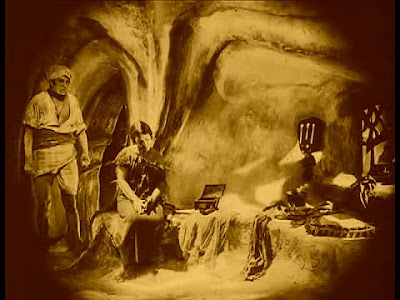What is it with the Germans and silent horror? No other country produced as many expressive tales of terror and the supernatural in the same time period, or did it so well. I'm tempted to say it was a national psychic predictor of the real-life horrors to come, but that's also kind of a silly thing to say. Maybe their folk tales were darker, maybe it's that pessimistic German fatalism that runs through many of the masterworks of German cinema (except for the Nazi years when German films were either cloyingly mindless entertainments about how amazing German life was or disgusting anti-Jewish propaganda), maybe it was a trend that took on a life of its own, maybe horror was looked at as a malleable canvas for German Expressionism's expansion into the movies. Whatever the reason, horror movies flourished in 1920s Germany and most of them were pretty damn good.
Waxworks is an anthology film with a unifying overall story directed by Paul Leni, an avant-garde painter turned filmmaker, best known for The Cat and the Canary and The Man Who Laughs. While one of the three stories within the larger story is a mixture of adventure and comedy, the other two are much darker. All three stories take place on incredible Expressionist sets designed by Leni himself with performances from big names in German silent film.
The film begins at a nightmarish-looking carnival. A man is wandering around nervously with a newspaper advertisement for a strange job offer as a writer of scenarios for the figures in the carnival's wax museum tent. The man (future Hollywood director William Dieterle, who also worked as an assistant director here) meets the gnarly old proprietor of the wax museum (John Gottowt) and a woman who works for the proprietor (Olga Belajeff). They all hit it off. The carnival tent isn't quite Madame Tussaud's and has only three wax figures: the caliph of Bagdad, Ivan the Terrible, and Jack the Ripper (also referred to as Spring-Heeled Jack throughout, even though one is a historical figure and the other a figure in folk tales). The old man wants the young writer to come up with stories for each figure. He gets inspired, and we see the results.
In the first tale, a baker in Bagdad (Dieterle again) gets on the wrong side of the caliph (Emil Jannings) when the smoke from his ovens wafts into the palace and throws the corpulent caliph off his chess game. He sends his right-hand man and his lackeys to the bakery to behead the man, but his advisor sees how beautiful the baker's wife is (Belajeff again) and forgets to do any beheading. He goes back and tells the caliph to get an eyeful of the babe. Meanwhile, the baker and his wife get into a big argument because he got flour on her one good dress and she's bored with the life of a baker's wife. The baker loses it and says he's going to kill the caliph and steal his wishing ring to prove what a man he is to his irritated wife. While the baker's out, the caliph sneaks into the baker's home to get a look at his wife, comical misunderstandings and hijinks occur, and things resolve happily through her intelligence and charm.
Things don't go as well in the second tale. In the much darker world of Ivan the Terrible (Conrad Veidt), the crazed Russian ruler is busy poisoning everyone, imagining slights and conspiracies everywhere, and generally acting creepy. The action reaches its frenzy at a wedding between Dieterle and Belajeff that Ivan turns into a dark time for everyone, including himself. Veidt (The Cabinet of Dr. Caligari, The Hands of Orlac, The Man Who Laughs, Casablanca) gives his usual intense, charismatic performance, and he's a natural fit for Ivan the Terrible. The sets aren't quite as exaggeratedly expressionistic in this segment, but remain visually stunning in this dark, wintery, snow-filled story.
The final tale unfolds in a full-on Caligari-esque nightmare world, as our writer and the woman he has become enchanted with are chased through a distorted version of the carnival by Spring-Heeled Jack (Werner Krauss). This is the shortest story with the least amount of dialogue, and the closest in tone to modern horror.
Leni has made a visually sumptuous film with incredible set design and wild, enjoyable performances. It's pretty slight compared to some of the towering masterpieces of silent German film, but it's an enjoyable, expressive entertainment worth your time.
One last word about Emil Jannings, the actor who played the caliph of Bagdad. Jannings is well-known to film buffs for his performances in F.W. Murnau's The Last Laugh and Faust and Josef Von Sternberg's The Blue Angel. He was the first person to win the Academy Award for Best Actor in 1929, but he actually lost the vote when the Academy counted ballots. Rin Tin Tin received the most votes that year, but the Academy decided they would look like fools if they gave the very first Best Actor Oscar to a dog, so the decision was quickly made to award second-place Jannings the statue. Jannings, unlike most of his talented peers, stayed in Germany during the Nazi regime and cowardly and opportunistically acted in Nazi propaganda films. When the Allies entered Germany in 1945, Jannings cowardly and opportunistically carried his Oscar around with him to try and ingratiate himself with the Americans. It didn't work. The proof of his Nazi collaboration was onscreen, and no one ever gave Jannings another acting role.
Sunday, December 13, 2015
Subscribe to:
Post Comments (Atom)











No comments:
Post a Comment